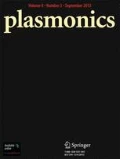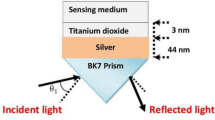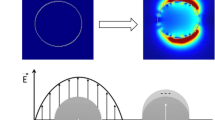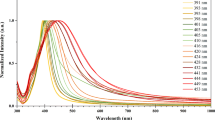Abstract
In this research work, a novel highly sensitive refractive index sensor using Au and Ag elliptic-shaped nanoparticles are proposed. The main idea of this work is using an original elliptic-disk nanoparticle that, in constant volume, is decomposed into two particles as a form of smaller elliptic-disk up elliptic-ring to improve the sensitivity. The better optical sensing properties of the proposed nanostructure are the main factor before considering their details. The optimum arrangement is found to have strong vertical coupling, and hence a high sensitivity. A plasmonic resonance peak takes place for the new nanostructure. The sensitivity of 320 nm/RIU and full width at half maximum (FWHM) of 66.5 nm is obtained for Au elliptic-disk nanoparticles. It is important to mention that these values are 260 nm/RIU and 57.3 nm for Au circular-disk nanoparticles, respectively. By decomposing the Au elliptic-disk as a form of elliptic-disk up elliptic-ring, the sensitivity is increased to higher than 440 nm/RIU. Also, the FWHM of the detector is 55.3 nm, and its figure of merit (sensitivity/FWHM) is 7.95. A nanostructure of Ag shows a sensitivity of 416.6 nm/RIU. Its FWHM and FOM are 51.1 nm and 8.15, respectively. The arrangement of decomposed nanoparticles causes the field to be remarkably enhanced at their point of coupling.








Similar content being viewed by others
Data Availability
The datasets used and/or analyzed during the current study are available from the corresponding author on reasonable request.
References
Qiu G, Yue Y, Tang J, Zhao YB, Wang J (2020) Total Bioaerosols detection by a succinimidyl-ester-functionalized plasmonic biosensor to reveal different characteristics at three locations in Switzerland. Environ Sci Technol
Heidarzadeh H (2020) Analysis and simulation of a plasmonic biosensor for hemoglobin concentration detection using noble metal nano-particles resonances. Optics Communications 459:124940
Liu J, Jalali M, Mahshid S, Wachsmann-Hogiu S (2020) Are plasmonic optical biosensors ready for use in point-of-need applications? Analyst
Heidarzadeh H (2018) Comprehensive investigation of core-shell dimer nanoparticles size, distance and thicknesses on performance of a hybrid organic-inorganic halide perovskite solar cell. Mater Res Express 5(3):036208
Jangjoy A, Bahador H, Heidarzadeh H (2019) Design of an ultra-thin silicon solar cell using localized surface plasmonic effects of embedded paired nanoparticles. Optics Communications 450:216–221
Mokari G, Heidarzadeh H (2019) Efficiency enhancement of an ultra-thin silicon solar cell using plasmonic coupled core-shell nanoparticles. Plasmonics 14(5):1041–1049
Heidarzadeh H, Mehrfar F (2018) Effect of size non-uniformity on performance of a plasmonic perovskite solar cell: an array of embedded plasmonic nanoparticles with the Gaussian distribution radiuses. Plasmonics 13(6):2305–2312
Agrawal A, Cho SH, Zandi O, Ghosh S, Johns RW, Milliron DJ (2018) Localized surface plasmon resonance in semiconductor nanocrystals. Chem Rev 118(6):3121–3207
Link S, El-Sayed MA (1999) Spectral properties and relaxation dynamics of surface plasmon electronic oscillations in gold and silver nanodots and nanorods. ACS Publications,
Sannomiya T, Hafner C, Vörös J (2009) Shape-dependent sensitivity of single plasmonic nanoparticles for biosensing. Journal of biomedical optics 14(6):064027
Miller MM, Lazarides AA (2006) Sensitivity of metal nanoparticle plasmon resonance band position to the dielectric environment as observed in scattering. J Opt A: Pure Appl Opt 8(4):S239
Zhang J, Liu H, Wang Z, Ming N (2007) Shape-selective synthesis of gold nanoparticles with controlled sizes, shapes, and plasmon resonances. Adv Func Mater 17(16):3295–3303
Zou S (2008) Light-driven circular plasmon current in a silver nanoring. Opt Lett 33(18):2113–2115
Barbosa S, Agrawal A, Rodríguez-Lorenzo L, Pastoriza-Santos I, Alvarez-Puebla RA, Kornowski A, Weller H, Liz-Marzán LM (2010) Tuning size and sensing properties in colloidal gold nanostars. Langmuir 26(18):14943–14950
Kim S, Jung JM, Choi DG, Jung HT, Yang SM (2006) Patterned arrays of Au rings for localized surface plasmon resonance. Langmuir 22(17):7109–7112
Nikoobakht B, El-Sayed MA (2003) Preparation and growth mechanism of gold nanorods (NRs) using seed-mediated growth method. Chem Mater 15(10):1957–1962
Sun Y, Xia Y (2002) Shape-controlled synthesis of gold and silver nanoparticles. Science 298 (5601):2176–2179
Iu H, Li J, Ong H, Wan JT (2008) Surface plasmon resonance in two-dimensional nanobottle arrays. Opt Express 16(14):10294–10302
Su KH, Wei QH, Zhang X, Mock J, Smith DR, Schultz S (2003) Interparticle coupling effects on plasmon resonances of nanogold particles. Nano Lett 3(8):1087–1090
Huang X, El-Sayed IH, Qian W, El-Sayed MA (2007) Cancer cells assemble and align gold nanorods conjugated to antibodies to produce highly enhanced, sharp, and polarized surface Raman spectra: a potential cancer diagnostic marker. Nano Lett 7(6):1591–1597
Halas NJ, Lal S, Chang W-S, Link S, Nordlander P (2011) Plasmons in strongly coupled metallic nanostructures. Chem Rev 111(6):3913–3961
Jain PK, El-Sayed MA (2008) Surface plasmon coupling and its universal size scaling in metal nanostructures of complex geometry: elongated particle pairs and nanosphere trimers. J Phys Chem C 112(13):4954–4960
Jain PK, El-Sayed MA (2007) Universal scaling of plasmon coupling in metal nanostructures: extension from particle pairs to nanoshells. Nano Lett 7(9):2854–2858
Wang H (2018) Plasmonic refractive index sensing using strongly coupled metal nanoantennas: nonlocal limitations. Sci Rep 8(1):1–8
Jain PK, El-Sayed MA (2008b) Noble metal nanoparticle pairs: effect of medium for enhanced nanosensing. Nano Lett 8(12):4347–4352
Hamamoto K, Micheletto R, Oyama M, Umar AA, Kawai S, Kawakami Y (2006) An original planar multireflection system for sensing using the local surface plasmon resonance of gold nanospheres. J Opt A: Pure Appl Opt 8(3):268
Zhang S, Panikkanvalappil SR, Kang S, Smith MJ, Yu S, El-Sayed M, Tsukruk VV (2019) Enhancing plasmonic-photonic hybrid cavity modes by coupling of individual plasmonic nanoparticles. J Phys Chem C 123(39):24255–24262
Kelly KL, Coronado E, Zhao LL, Schatz GC (2003) The optical properties of metal nanoparticles: the influence of size, shape, and dielectric environment. ACS Publications,
Kottmann JP, Martin OJ, Smith DR, Schultz S (2000) Spectral response of plasmon resonant nanoparticles with a non-regular shape. Opt Express 6(11):213–219
Malikova N, Pastoriza-Santos I, Schierhorn M, Kotov NA, Liz-Marzán LM (2002) Layer-by-layer assembled mixed spherical and planar gold nanoparticles: control of interparticle interactions. Langmuir 18(9):3694–3697
Gonçalves MR, Marti O (2003) Experimental observation of the scattering of light by planar metallic nanoparticles. New J Phys 5(1):160
Draine BT, Flatau PJ (1994) Discrete-dipole approximation for scattering calculations. Josa a 11(4):1491–1499
Khlebtsov NGe, (2008) Optics and biophotonics of nanoparticles with a plasmon resonance. Opt Quantum Electron 38(6):504
Montgomery JM, Lee T-W, Gray SK (2008) Theory and modeling of light interactions with metallic nanostructures. J Phys: Condens Matter 20(32):323201
Fort E, Grésillon S (2007) Surface enhanced fluorescence. J Phys D Appl Phys 41(1):013001
Jensen T, Kelly L, Lazarides A, Schatz GC (1999) Electrodynamics of noble metal nanoparticles and nanoparticle clusters. J Cluster Sci 10(2):295–317
Jung LS, Campbell CT, Chinowsky TM, Mar MN, Yee SS (1998) Quantitative interpretation of the response of surface plasmon resonance sensors to adsorbed films. Langmuir 14(19):5636–5648
Johnson PB, Christy RW (1972) Optical constants of the noble metals. Phys Rev B 6(12):4370
Wei QH, Su KH, Durant S, Zhang X (2004) Plasmon resonance of finite one-dimensional Au nanoparticle chains. Nano Lett 4(6):1067–1071
Tsai CY, Chang KH, Wu CY, Lee PT (2013) The aspect ratio effect on plasmonic properties and biosensing of bonding mode in gold elliptical nanoring arrays. Opt Express 21(12):14090–14096
Chang KH, Cheng JS, Lu TW, Lee PT (2018) Engineering surface lattice resonance of elliptical gold nanodisk array for enhanced strain sensing. Opt Express 26(25):33215–33225
Fu J, Park B, Zhao Y (2009) Limitation of a localized surface plasmon resonance sensor for Salmonella detection. Sensors and Actuators B: Chemical 141(1):276–283
Haes AJ, Van Duyne RP Nanoscale optical biosensors based on localized surface plasmon resonance spectroscopy. In: Plasmonics: metallic nanostructures and their optical properties, 2003. Int Soc Opt Photo, pp 47–58
Sun Y, Xia Y (2003) Gold and silver nanoparticles: a class of chromophores with colors tunable in the range from 400 to 750 nm. Analyst 128(6):686–691
Acknowledgments
The authors acknowledge the Department of Electrical and Computer Engineering at the University of Mohaghegh Ardabili for various facilities.
Author information
Authors and Affiliations
Contributions
HB and HH contributed to this work in the data analyzing and the structures simulating. All authors read and approved the final manuscript.
Corresponding author
Ethics declarations
Competing Interests
The authors declare that they have no competing interests.
Additional information
Publisher’s Note
Springer Nature remains neutral with regard to jurisdictional claims in published maps and institutional affiliations.
Rights and permissions
About this article
Cite this article
Bahador, H., Heidarzadeh, H. A New Proposal for Highly Sensitive Refractive Index Sensor Using Vertically Coupled Plasmonic Elliptic-Disk up Elliptic-Ring Nanoparticles. Plasmonics 16, 1223–1230 (2021). https://doi.org/10.1007/s11468-021-01382-0
Received:
Accepted:
Published:
Issue Date:
DOI: https://doi.org/10.1007/s11468-021-01382-0




